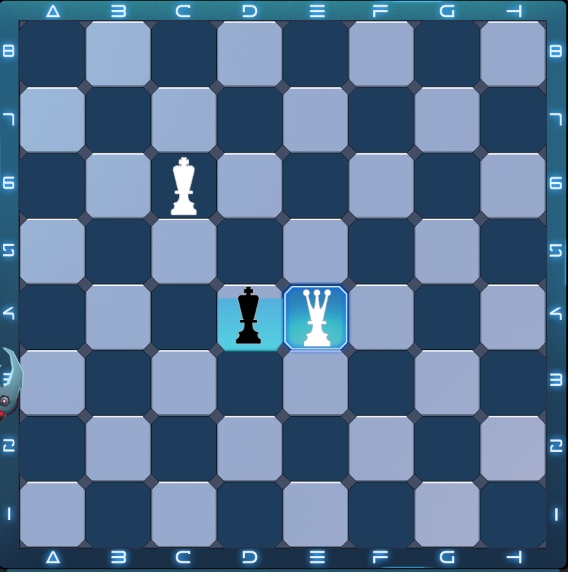Tactical tricks
Part 1: Dirty tricks
Dirty tricks should never work. That's the thing we'd like to begin with. You will succeed only in case your opponent doesn't expect it to happen. So this means that after reading this guide,
you'll rarely be a victim of someone's tricks and steal the "victory" from those who aren't aware of such tricks.
These tricks are working out better when you know when and how your opponent is going to move his piece.
Trick №1

The black king will run out of charge earlier than the white one. The white king cannot defend its queen securely; that's why this game is more likely to end up with a draw.

Whites can use the first dirty trick to avoid the draw. The whites do know that the black king may take the queen at the very moment when the king's charge will end up (the longer waiting allows the white queen to recharge). That is why the whites will put their king at risk when blacks run out of charge.

The blacks probably will take the white queen, but later they will be caught by the white king.

The white king will be recharged just in time to take the black king.
Risky stuff. Early moving of the king may give time and let the blacks switch from taking the queen on taking the king. Moving the piece too late will allow the black king to do the recharge first in the diagram above. Deal with the timing to make this tactic effective.
Trick №2

We do not recommend to use it more than once as your opponents will not buy it twice.
The white bishop is going to take the black king.

Again, you know when the black king is about to make a move, and you know that your human opponent cannot move two pieces at once.

Knight's attack on the black queen at the same moment when the bishop forces the king to make a move is most likely to end up with the queen's win. As has been mentioned before, do not try to use this trick more than once.
Part 2: Timing Trick
Trick №3

In this quite weird game, the black rook has tried to take the unprotected knight; but the whites have quickly reinforced it with the king, and in the diagram, they are almost ready to act in revenge.

The whites do remember about taking the rook and move the pawn on e7 for blocking, provided the blacks move their king on d6, so they willingly make this move. Believing they have provided taking the second rook, the whites were preparing for finishing their opponents.

But the blacks appeared to be careful; they have foreseen everything and found out the following.

This move confused the whites being played as quickly as possible. They found out that they are not capable of taking the black king before their own was captured. After that, the player of the white pieces told that he hadn't even considered such a capture, thinking his position was secure. "Just got lucky," you may say. But the timing really can be helpful, as you may see.
Trick №4

Most of the players miss this timing trick. At first, the whites move the rook on f5:

Now the whites are threatening with combined attack on black bishop and pawn. The whites know that the blacks will soon move their bishop, hence they are ready to capture the pawn by king when the bishop moves:

As the whites have taken the pawn immediately after the black bishop's move, the white king has enough time to avoid capture.
Part 3: Blocking tricks

In this position, the black pawn promotes the first and will capture the white one when it is promoted.

It looks quite gloomy for the whites. But they have a tricky enough block to save themselves.

The whites put their king against the black queen blocking its way to the white pawn.

And it's a draw.
Trick №5

In this position, the whites just have done the combination on the queenside flank using the knight and bishop (see the 4th part to learn more). After the blacks capture the whites' knight, the whites will be eager to take it back with the bishop and defend it with the pawn.

But if the blacks are quick enough, they may keep the pawn out from defending the bishop by a tricky blocking:

It's just the tip of the iceberg. There are many more tactical tricks in action-chess. We haven't yet touched upon the inmove captures (not en passant), but we will speak about it in the next guide.
Strategy Examples in Click-Storm Action Chess. Part 12
Other topics on CLick-Storm Action Chess are here:










Last Opinions